I don't really know what that place is and I just went along lah... cos we saw it in the inteniary our friend sent us of what they did when they went to Istanbul. After I visited the palace though, I am super amazed that our friends spent like 1.5 hours there only.. we were there for a good 4 hours and even so, we did not manage to see EVERYTHING inside the palace.
This palace is so big, we had so many pictures I had to split the post about the palace into two!:)
We did not know that the Topkapi Palace was right next to Haggia Sofia and took a long long walk over:) Along the way, saw these lovely leather shoes.. usually when we take photos.. the shopkeepers are happy one.. this one came out and scolded us.. dun care lah. we just say sorry.. anyway, ALREADY TAKE:)
We passed by a restaurant tat says they sell vegeterian Testi Kehbab.. we were contemplating eating this for lunch today:) hee hee..
As Istanbul is a very old city, there are many many old old buildings like that... and because they have ever been under Rome and Greece rule.. and also because one of the Sultan's mother is from France, it seems that their architecture has alot of european influences.. But it is apparently considered Ottoman Style Architecture..
We walked a long way to reach this gates... once you go through, you will see lots of tulips...
Tulips galore! Max went crazy taking pictures!:) wahahaha
Cats are a big thing here in Istanbul I think.. they can be seen everywhere..
Walking uphill to go to Topkapi Palace..
We noticed while going past one of the archeological museum that most of the statues have got no heads.. I wonder if it is a result of pillage since this place underwent so many times of change in rulers..
Istanbul was once part of the roman empire and designated as THE CITY (which is the meaning of the name Istanbul) and so I think it is not unusual to find these roman looking relics. Anyway, there has been some archeological work being done in Haggia Sofia.. one of the oldest buildings here.. and the things they have found are left on the slopes that we walked up across.. we saw water baths, coffins, statues... as we walked uphill...
And of course, we saw lots of tulips!:)
Max get grumbling and complaining that we were here too early.. because some of the flowers have not opened.. I thought we were just nice cos if we were here later, most of the flowers that have already bloomed would already have withered..
Max taking photos again..
Ace managed to capture us when we were posing and taking pictures:) haha
More relics... it is amazing how they can carve such great detail in stone, don't you think?
Reached a gate with guards... asked Ace if he wanted to take photos with them but Ace did not want.. they so handsome wor..
Walking past the archeological museum.. which was partially undergoing some sort of renovation..
Walked around and saw this place where you can look out at sea. But no entry into this road...
The view was pretty though...
When we arrived at the outside of Topkapi palace, we saw lots of people queuing up!
We decided to walk walk and see what there could be in the surrounding area anda church that looked like Haggia Sophia.. actually is called Haggia Irene... it was built during the Byzantine period and was a church... The Church of Hagia Irene was never destroyed by the conquering Ottomans and survived by being used as a storehouse and imperial armory...
We realized that there is this gate tat allowed us to cut through from Haggia Sofia to The Topkapi Palace. Probably was how the Sultan went to do his prayers when Haggia Sophia was the Imperial Mosque or something..
I read wikipedia later and found out that this is known as the Imperial Gate... I quote from wiki..
"The Mese was used for imperial processions during the Byzantine and Ottoman era. It leads directly to the Hagia Sophia and takes a turn northwest towards the palace square where the landmark Fountain of Ahmed III stands. The sultan would enter the palace through the Imperial Gate (Turkish: Bâb-ı Hümâyûn or Latin: Porta Augusta), also known as "Gate of the Sultan" (Turkish: Saltanat Kapısı) located to the south of the palace.... Gilded Ottoman calligraphy adorns the structure at the top, with verses from the Qur'an and tughras of the sultans. Identified tughras are of Sultan Mehmed II and Abdül Aziz I, who renovated the gate....
One of the inscriptions at the gate proclaims:
By the Grace of God, and by His approval, the foundations of this auspicious castle were laid, and its parts were solidly joined together to strengthen peace and tranquility. This blessed castle, with the aim of ensuring safety of Allah's support and the consent of the son of Sultan Mehmed, son of Sultan Murad, sultan of the land, and ruler of the seas, the shadow of Allah on the people and demons, God's deputy in the east and west, the hero of water and soil, the conqueror of Constantinople and the father of its conquest, Sultan Mehmed Khan- May Allah make eternal his empire, and exalt his residence above the most lucid stars of the firmament."
According to old documents, there was a wooden apartment above the gate area until the second half of the 19th century.[18] It was used first as a pavilion by Mehmed, later as a depository for the properties of those who died inside the palace without heirs and eventually as the receiving department of the treasury. It was also used as a vantage point for the ladies of the harem on special occasions."
We walked through the gate to see see look look and found ourselves here.. and then.. we realized later, that this place is just a few minutes away from our hotel... we have gone almost one full circle!:) wahaha...
Haggia Sophia...
Decided to walk back and join the queue as it was super long... While Max was queuing up, I walked around to see see look look lor...
I dunno why.. but when I first went close to the gates to take a picture of what looked like the main entrance into the palace area, the two towers actually reminded me of Disneyland!:) wahahahaa...
But of course, it has NOTHING to do with Disneyland lah..
According to wikipedia, this gate is called The large Gate of Salutation (Arabic: Bâb-üs Selâm), also known as the Middle Gate (Turkish: Orta Kapı), leads into the palace and the Second Courtyard.
Saw the museum shop and went inside with Ace to reckee the place.. THere are so many jewel adorned stuff.. apparently, Ottomans had lots of spoils of war... and many of them were jewel adorned stuff like stationary lah.. weapons lah.. all got jewel on it.. even saw a whole throne adorned with jewels of all diff shapes and sizes... Too bad though they did not allow photography inside the exhibition area of these stuff...
When I saw this in the shop I thought this is a fan.. later at the exhibition inside the palace, i found out that this is somewhat like a symbol of the throne...
Saw people wearing the traditional Ottoman Costumes and asked Mx if he wanted to do it too.. i tot quite fun.. but he dun wan.. so too bad lor..
wilting tulip that looked pretty anyway:)
Wah lau.. queue so long.. dunno when we can get there...
We bought the museum pass in the end. It will allow us to visit a few museums for one ticket price.. since we are going to do tat anyway, we thought this is a better deal...
Finally got into the palace proper...
A little bit of info about the palace from Wiki...
The Topkapı Palace (Turkish: Topkapı Sarayı[1] or in Ottoman Turkish: طوپقپو سرايى) is a large palace in Istanbul, Turkey, that was the primary residence of the Ottoman Sultans for approximately 400 years (1465-1856) of their 624-year reign....the palace was also a setting for state occasions and royal entertainments....
After the 17th century the Topkapı Palace gradually lost its importance as the sultans preferred to spend more time in their new palaces along the Bosphorus. In 1856, Sultan Abdül Mecid I decided to move the court to the newly built Dolmabahçe Palace, the first European-style palace in the city....
The palace complex is located on the Seraglio Point (Sarayburnu), a promontory overlooking the Golden Horn and the Sea of Marmara, with a good view of the Bosphorus from many points of the palace. The site is hilly and one of the highest points close to the sea. During Greek and Byzantine times, the acropolis of the ancient Greek city of Byzantion stood here....
After the Ottoman conquest in 1453, Sultan Mehmed II found the imperial Byzantine Great Palace of Constantinople largely in ruins... they initially set up a court in the Old Palace and the Sultan searched for a better location and chose the old Byzantine acropolis, ordering the construction of this new palace in 1459.
Check out this model of the palace...
Such a huge building! Apparently it is a complex buildling and at one time housed 40,000 inhabitants! It was like a city within a city and has everything you might ever need.. so apparently the inhabitants rarely needed to go outside of the palace for anything!
Here is a little titbit about the Ottoman Empire... Apparently, according to wikipedia...
The Ottoman Empire (Ottoman Turkish: دَوْلَتِ عَلِيّهٔ عُثمَانِیّه ) was also known as the Osmanli Empire.. It was an empire founded by Oghuz Turks in 1299... With the conquest of Constantinople (Istanbul's old name) by Mehmed II in 1453, the Ottoman state was transformed into an empire that straddles between both Europe and Asia....
This map shows how the empire has grown during the 16th and 17th centuries, in particular at the height of its power under the reign of Suleiman the Magnificent. At the height of their grandeur, the Ottoman Empire was one of the most powerful states in the world – a multinational, multilingual empire, controlling much of Southeast Europe, Western Asia, the Caucasus, North Africa and the Horn of Africa....
With Constantinople as its capital and control of vast lands around the Mediterranean basin, the Ottoman Empire was at the centre of interactions between the Eastern and Western worlds for over six centuries.... (In fact, after research, I discovered that parts of the UAE were actually under Ottoman Rule during the 16th century)
Sadly though, their downfall came in the aftermath of World War I; the collapse of the empire led to the emergence of the new state of Turkey in the Ottoman Anatolian heartland, as well as the creation of modern Balkan and Middle Eastern states.
Interesting.. no wonder I find there is alot of shared culture like the use of shapes and similarities in cuisines between UAE and Turkey...
Saw this large gree and reminded me of Ah Meng from the Singapore Zoo... can you see the similarity?
The same tree from a different view.. turns out that it is a Sycamore Tree
Uncle Max taking photos again!:)
Inside the courtyard, there are lots of flowers:)
First place we visited was the Chambers of the Imperial Council. This is where the council met and discussed important issues about the country leh...Probably where the decision to kill, save or change millions or lives are made...
Do you see the high tower behind the Chambers of the Imperial Council? That is called the Tower of Justice.
According to wikipedia...
The Tower of Justice (Adalet Kulesi) is located between the Imperial Council and the Harem. The tower is several stories high and the tallest structure in the palace, making it clearly visible from the Bosphorus as a landmark....The tower symbolizes the eternal vigilance of the sultan against injustice. Everyone from afar was supposed to be able to see the tower to feel assured about the sultan's presence....
The tower was also used by the sultan for viewing pleasures. The old tower used to have grilled windows, enabling him to see without being seen, adding to the aura of seclusion. The golden window in the Imperial Council is accessible through the Tower of Justice, thus adding to the importance of the symbolism of justice...
Doorway of the imperial council..
I got the next 3 pictures from an amazing blog called 91 Days In Istanbul... amazing photography they have...
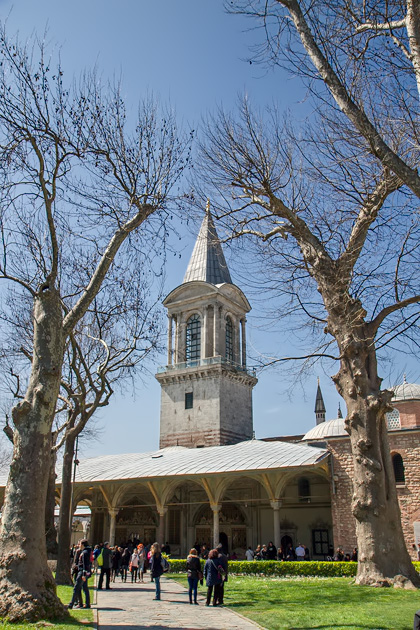
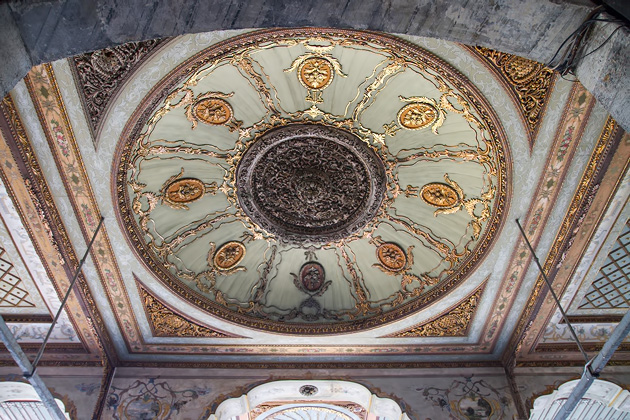
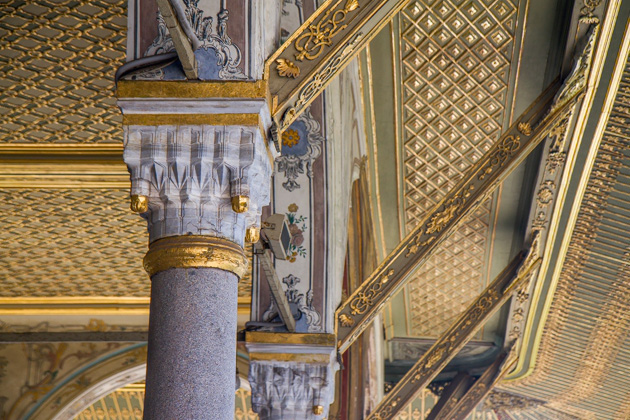 You can see so much detail in these excellent photos from 91 Days In Istanbul
You can see so much detail in these excellent photos from 91 Days In Istanbul Ok back to the lousy pics from my Samsung Note 2:) wahahaha...
Very typical designs inside.. too bad some parts are like mouldy and all that.. I am surprised they did not try to restore...
Lots of patterns and turkish designs..
Our pics are not so clear.. attached is a pic from wikipedia....
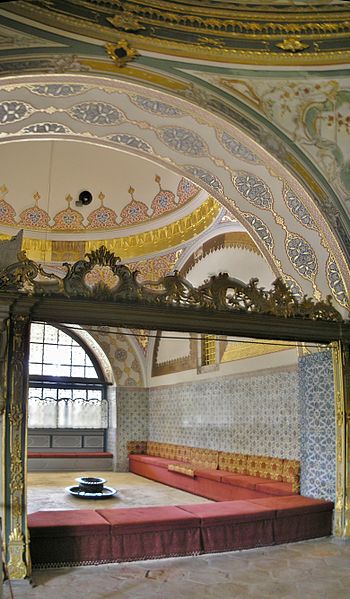
THen we came to this place called the Gate Of Felicity. The Gate of Felicity (Bâbüssaâde or Bab-üs Saadet) is the entrance into the Inner Court (Enderûn), also known as the Third Courtyard, marking the border to the Outer Court or Birûn. The Third Courtyard comprises the private and residential areas of the palace. The gate has a dome supported by lean marble pillars. It represents the presence of the Sultan in the palace.[53] No one could pass this gate without the authority of the Sultan.

There was a clock exhibition in the palace as well...
Apparently during that time, there were alot of craftsmen who made european style clocks for the ottoman palaces..
At this point, I cannot take photo liao.. i only took the first three cos I did not realize there was a no camera sign.. police man said cannot take.. so i din take liao lor...
Apparently, according to this article I read on the internet... there is a reason why there are so many clocks found in the palace... I include and excerpt here but you can read the full article by Paul Horton here if you are interested...
"In 1923, when the last of the Ottoman Sultans left Istanbul for exile and the new Republican regime decreed that the dynasty's sumptuous palaces along the Bosporus should become museums, officials undertook a house-cleaning that uncovered rooms and closets stuffed with collections of art and royal paraphernalia, much of it long-forgotten gifts from emperors, kings and dignitaries who had once sought the favor of the mighty Ottoman court....
In the vast Topkapı Palace, they discovered a little-known legacy of Turkey's Ottoman past. Sorting through a collection of more than 100 splendid clocks and watches, most in perfect condition, they found among such gifts from Europe as 19th-century English and French floor clocks, a small collection of timepieces, dating from the 16th century, which bore craftsmen's names inscribed in Ottoman script. These were clocks and watches which had been made in the Ottoman empire, and in both the technical precision of their works and the lavish embellishment of their cases they were stunning examples of the clockmaker's art.....
The Ottomans are usually thought of as soldiers rather than technicians, and even much of the "Ottoman" art and architecture created during their 400-year reign was the work of various urban minority groups, who themselves borrowed heavily from the legacy of Byzantium. How did it happen, then, that Ottoman craftsmen turned to the intricate and demanding art of clock making?
Religion was probably the main reason. As Muslims, Turks were obliged to pray five times daily, and since the time of the Prophet in the seventh century, Islamic religious leaders had been concerned with devising ways of determining these prayer times. Since timepieces were unknown in Arabia during the Prophet's lifetime, the desert Arabs worked out a rough method of determining prayer times by observing the varying phases of the sun. ... This method was used with slight changes until the Muslim armies moved out of the Arabian Peninsula into Palestine and Syria, where they first came into contact with sundials and water-clocks. Sundials, known since Greek times, were frequently used in conjunction with a simple water clock, a bowl with rings marked around the inside that were revealed as water flowed out of the bowl at a steady rate through a hole in its bottom. As the "day" was reckoned from sunset (Aramco World, March-April 1969), the hours indicating midday and midnight continually varied with the seasons, and to remedy this Muslim scholars devised almanacs to determine the precise hours of prayer according to the degree of longitude of each area. Most mosques used this system until well into the 16th century when mechanical clocks came into use, although there was a clock in the main minaret of the mosque in Damascus as early as the 13th century....
One, by the Arab scientist al-Jazari, called the "Book of Knowledge of Mechanical Contrivances," also known as the "Treatise on Automata," furnished detailed drawings of over 50 mechanical devices, including clocks. The other, by the astronomer Taqi al-Din Muhammad ibn Ma'ruf, published in Istanbul, described the mechanics of astrolabes and observational telescopes as well as weight-driven clocks. These indicated hours and minutes and could determine the time of prayer "without having to observe the heavenly bodies," that is, when indoors or on overcast days.
The detail provided by al-Jazari and Taqi al-Din amounted to a "how-to-do-it" manual for the Ottoman clockmakers, who seem to have been the first among Muslims to actually go ahead and construct an elaborate mechanical timepiece.... As in medieval Europe, where the first geared clocks are believed to have appeared in monasteries to help regulate the daily prayer services, so in Istanbul the first Turkish clocks were made in the tekkes, or monasteries, of the so-called "Turkish monks," the Mevlevi Dervishes, better known to Westerners as the "Whirling Dervishes." The Mevlevis were considered the most intellectual of the Dervish orders and were well known for their interest in music and the arts. They acquired an interest in making mechanical clocks, their elders now suggest, to help initiates of the order observe fixed prayer times during long periods of meditation. More reliable than sundials and not requiring as much attention as a waterclock, the clocks also provided a focus for the communal life of the monastery.
As artisans, the Mevlevis prided themselves on producing flutes, embossed swords and other objets d'art. Clock-making required a combination of talents..... it is apparent that the Mevlevis spent several years on each timepiece, with only the most basic of hand tools. Occasionally, the same artist would make the entire apparatus, from the inner gearwork to the intricately embellished case.... The outer design frequently took the shape of the Mevlevi headdress. This consisted of a felt hat like a tall, overturned plant pot, encircled at the base with a turban; it served as a symbol of the order and usually appeared as a sign on top of the tekke or on the Dervishes' gravestones....
Many of these timepieces, now on display at the Topkapı Palace, were presented to the Sultan by the Mevlevis as a sign of their loyalty.
The first non-Turkish clocks appeared in Istanbul early in the 16th century, when a delegation sent to Germany by Suleiman the Magnificent to attend the investiture of the Emperor Maximilian returned with several "clocks of value." An English traveler who visited one of the Sultan's palaces in the early 1700's described "tables of silver and precious woods, along with Persian carpets, Venetian mirrors and a gold English clock with a dome made of diamonds."... Soon the Sultan's various palaces were filled with clocks given by visiting European dignitaries, including floor models which played Turkish melodies, watches with an enameled portrait of the Sultan and dome-shaped table models in baroque style.
European clockmakers later opened branches in Istanbul and by the 18th century they were designing for the "Turkish market" models featuring a face with Arabic numerals and somewhat garish "oriental" encasements. These clocks became a common feature in well-to-do houses along the Bosporus.... Ottoman clockmakers also began to imitate the imported models."
I found some more pics of these beautiful watches and clocks on the internet..



Anyway after tat, we came out and saw this...
It is a column they just built in commemoration of the sultan's abilty to shoot a jug a large distance away. Like that also can ... hahaah
Then we came to this part of the palace.. which is the imperial treasury where spoils of wars and also gift from other countries are put up for display.. among them are beautiful stationary, cutlery, fashion accessories, jewels, sword of prophet Mohammed etc etc etc..
Max queiing up to go into the treasury..
We self entertain by taking pictures while waiting in the queue:)
"Kenny" Chua...
"Kenny" and his ah xiao father.. wahaha:)
We are finally at the doors!
Quickly took a picture of the room before I went in because no cameras again... Here are some pics I found online of some of the more impressive things we saw...
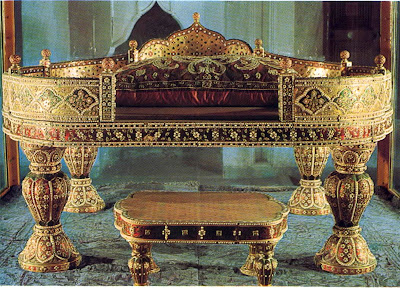
This is one of the treasures... it is a Indian Mughal looking throne called the Nadiri throne. This was gifted by the infamous Nadir Shah of Iran to the Ottoman emperors. It is believed to be one of the only Mughal Thrones left.. and I must say it is really very intricate.. with so many jewels put on it...

Porcelains during Ottoman reign.. I think the tea cups look quite english...
 The sultan's decorative armour for special occasions..
The sultan's decorative armour for special occasions..


Spoonmaker's Diamond.. one of the largest diamonds.. Set in silver, surrounded by a double row of 49 Old-mine cut diamonds (brilliants) and well spotlighted, it hangs in a glass case on the wall of the third room in Imperial Treasury section of Topkapı's "Conqueror’s Pavilion", where it is clearly the most eye-catching jewel.
These surrounding separate brilliants give it "the appearance of a full moon lighting a bright and shining sky amidst the stars". Providing an additional beauty to the Spoonmaker's Diamond and increasing its value by as much again, the brilliants are considered to have been ordered or arranged either by Ali Pasha or by Sultan Mahmud II – though this, as all other details of the diamond's origins, is doubtful and disputed..
Other things we saw....
| Gold matara - flask This flask has a distended, flattened, pouchlike body, and a short neck, and is set on a low, circular foot. Solid golden body decorated with pearls, repousse palmettes, emeralds and rubies. | |
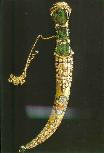
| The Topkapi dagger, 1746. |
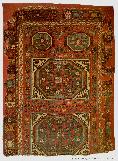
| Bergama rug of the Holbein type 16th century. |

| The Spoonmaker's Diamond. |
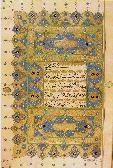
| An illuminated page from a Koran by Ahmet Karahisari. |
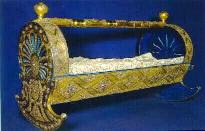
| Golden craddle, 16th century. |
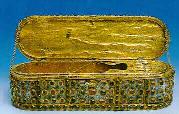
| Gold pen box. |

| Monogrammed (tughra) pendant Height = 20cms. In the form of an ostrich egg, enamelled in blue and pink, this pendant bears the tughra of Mahmut II (1808-1839) inscribed in diamonds, and foliate and floral motifs also studded in diamonds. A small diamond-encrusted seperate lobe hangs above the pendant and a cascade of pearls below. |
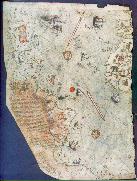
| The map of Piri Reis The map, which is drawn on parchment in colour, was executed by the Turkish geographer Piri Reis, a renowned cartographer of the 16th century. The map shows part of Europe and west coast of Africa, and eastern, central and south America, the Atlantic islands, and the ocean. A great deal of detail is given in South America. This map is in fact only the western section of the world drawn by Piri Reis and presented to Selim I in Cairo in 1517. It was prepared in Gelibolu. Piri Reis' map is the oldest known map which includes the continent of America. |
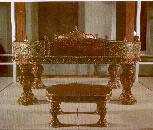
| The throne of Nadir Shah, 18th century. Irano - Indian. This throne was presented by the Shah of Iran to Mahmud I (1730-1754). Gold, precious stones and enamel embellish the throne. |
| Hanging wall clock, 18th century. | |
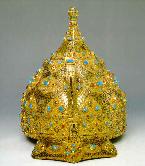
| Helmet, 16th century. |
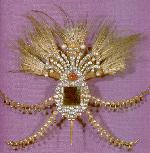
| Sultan's crest. 18th century. 28cms in height. Bears an emerald (4x5 cms), a ruby (3 cms), and framed by a row of diamonds and pearls. |
| Sweetmeat set Abdulhamid II period (1876-1909) | |
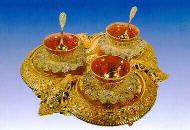
| Ice cream service, gold, cast and filigree. |
| Gold ceremonial throne MAde in 1585 by order of the vizier Ibrahim Pasha and presented to Murad III. | |
| The throne of Ahmed I The throne was the work of the architect of Sultanahmed mosque, Mehmet Aga. | |
| Rock - crystal flask. This flask, or matara, was one of the ceremonial vessels used to carry water for the use of the Sultan. Last quarter of the 16th century, H. 32.2 cm, D. 15.5 cm. | |
| Rock - crystal flask 16th century, H. 21 cm. | |
| Rock - crystal jug. The body and handle of the jug are carved from a single piece of rock - crystal. The remainder is also decorated with gold and jewels. 2nd half of 16th century, H. 20 cm. | |
| Swords Ornamanted with gold. | |
| Ewer Made of silver, enamel plated. 19th century. | |
| Inclaided flintlock guns 18th century. | |
| Zinc jug with lid 16th century. | |
| Rose - water flask Made of gold, enamelled with flower decorations. | |
| Coffee - ewer Made of silver, gold plated. 19th century. | |
| Rock - crystal and gold jug with lid 16th century. | |
| Jade tankard with lid 16th century. | |
| Emerald and diamond broach | |
| Gold sherbet set Four tugra monograms of Abdulaziz are set around the rim. | |
| Compote service in enamel | |
| Rose - water flasks Made of gold, enemelled and ornamanted with diamond |
How Turkey looks like across the sea:)
Saw these walls.. I wonder if they are part of the palace.. or part of the city walls.. I read that not much of the original city walls are left behind...
As we walked around.. there seemed to be lots of little gardens around the area...
Saw a rose among all the tulips:)
And this is the end of PART 1.. of our Topkapi Palace Adventure:) haha...
Previous Post: Istanbul Trip Part 3: Blue Mosque Sultan Ahmed
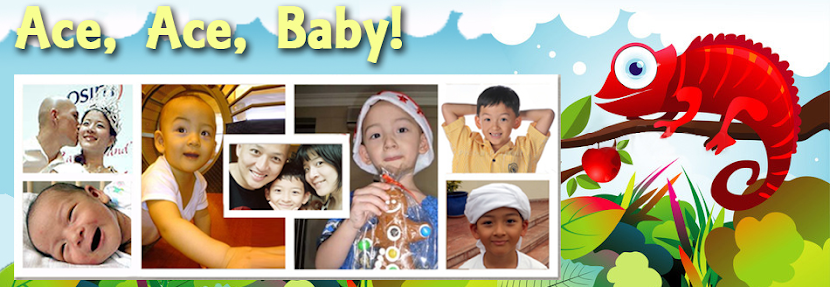






















































































































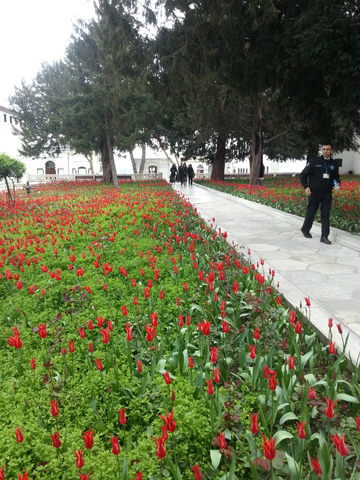

No comments:
Post a Comment